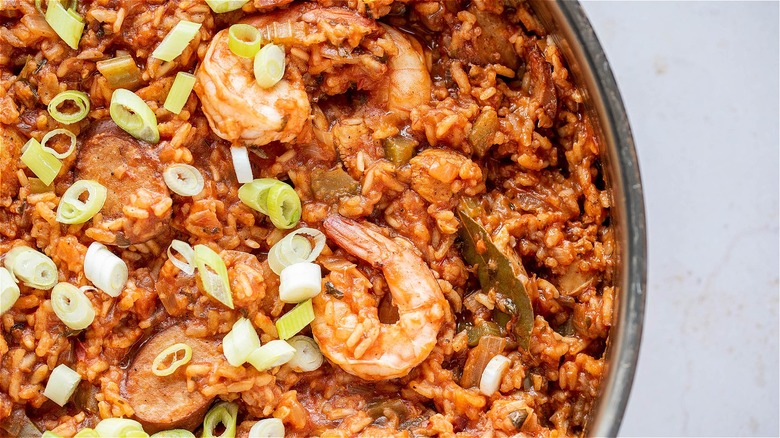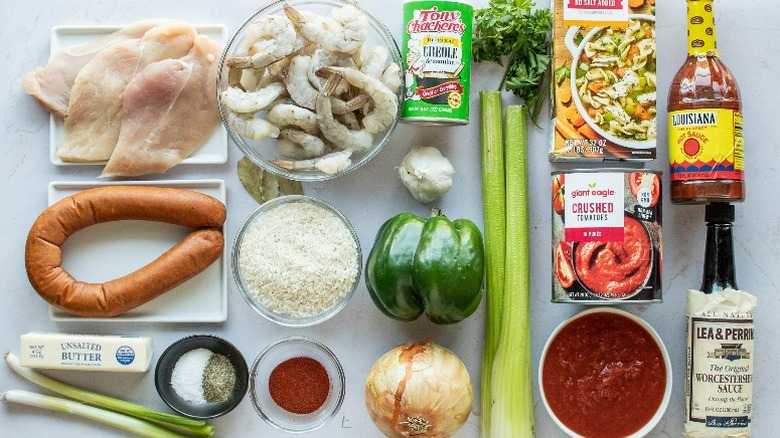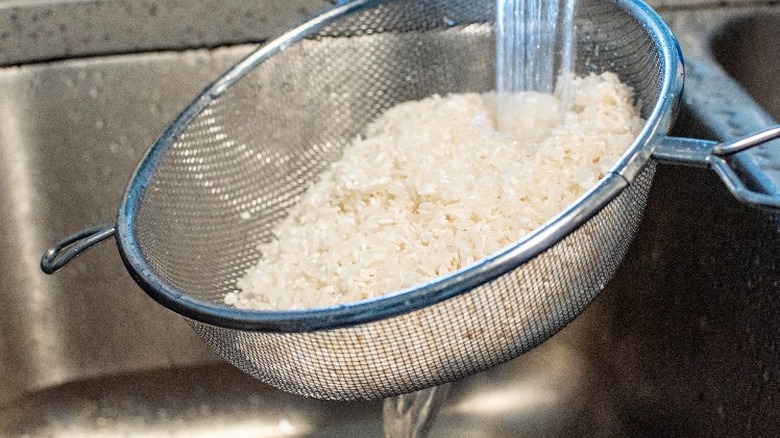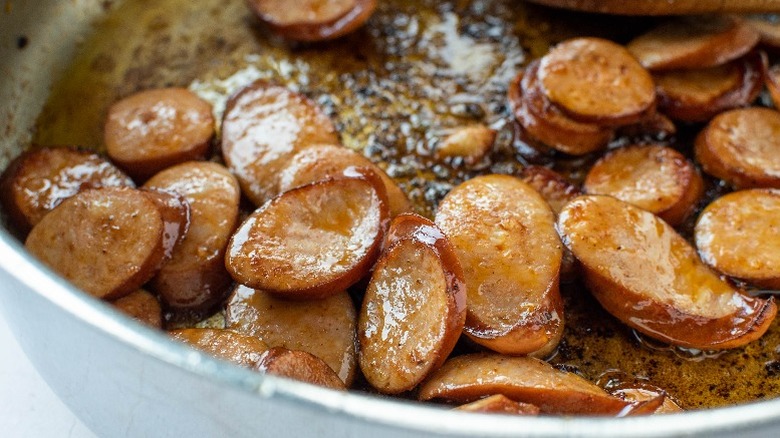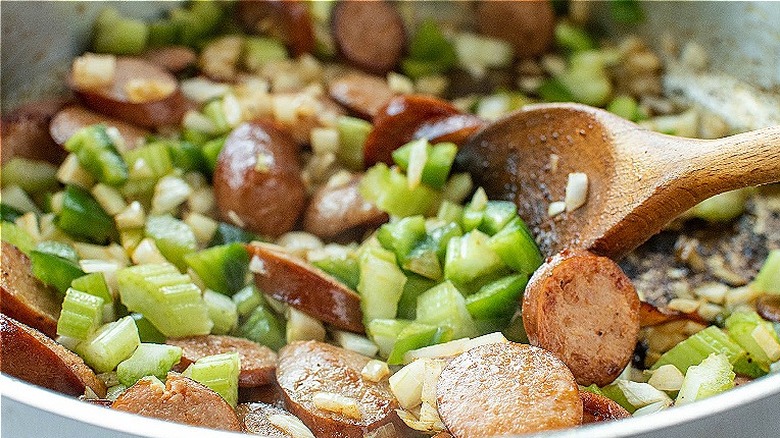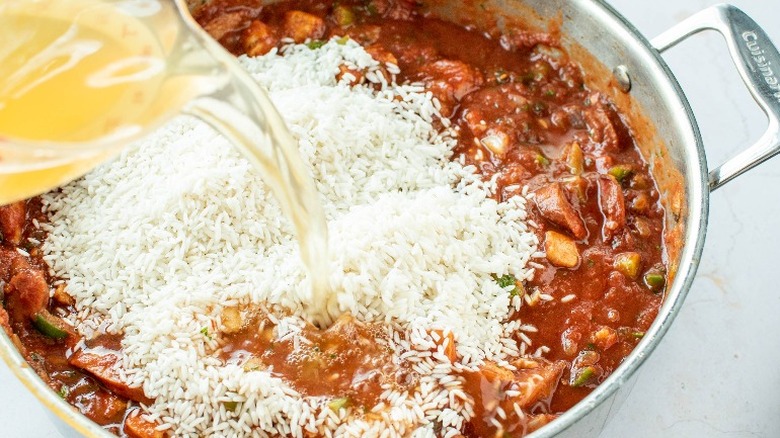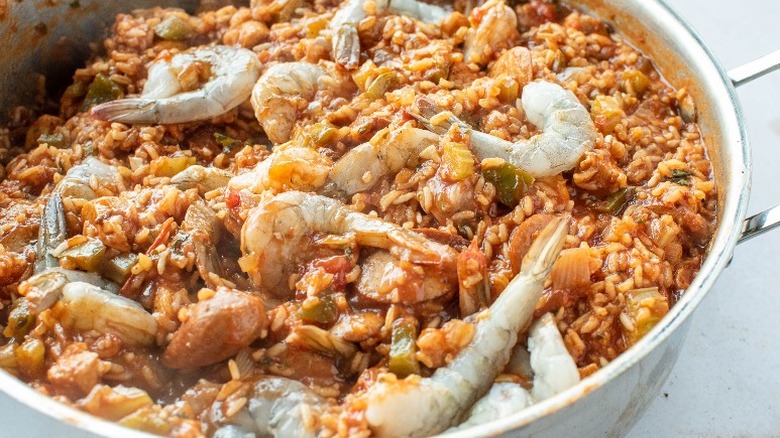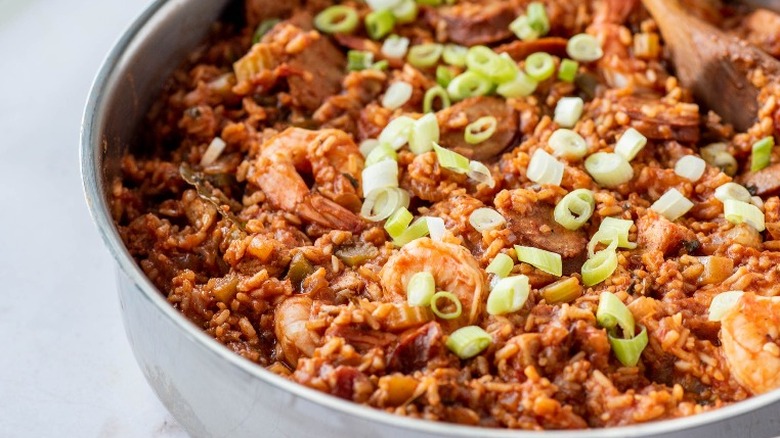Traditional Jambalaya Recipe
Louisiana is home to a robust culture, history, and cuisine; in New Orleans, the charming, colorful streets fill with jazz and the scent of sweet beignets. Throughout this southern state you'll find the world's most delicious Cajun and Creole foods like alligator, crawfish, étouffée, gumbo, and, of course, jambalaya. Jambalaya is a rice dish much like Spanish paella, in which rice is cooked with saffron, chicken, and seafood like shrimp and mussels. Similarly, jambalaya is cooked in one pot, layering flavors including andouille sausage, onion, pepper, and shrimp to create a bold and plentiful rice stew. Cajun and creole cooking differ slightly, especially in their jambalaya: while Creole jambalaya uses tomato, Cajun jambalaya does not. In this recipe, we guide you through a traditional Creole, tomato-based jambalaya, complete with the New Orleans' "holy trinity" of onion, celery, and green bell pepper. This recipe is made to be medium-level spicy, but if you want New Orleans heat, try doubling the hot sauce and cayenne.
Gather your jambalaya ingredients
While jambalaya is an easy, one-pot meal, it requires a lot of ingredients to achieve its delicious end result. First, you will need long-grain rice. You'll also need chicken cut into bite-sized pieces, thinly sliced andouille sausage, butter, and seasonings like salt, pepper, and cayenne.
Once the meats are cooked, you'll need Louisiana's Creole "holy trinity" of diced onion, celery, and green bell pepper. Additional seasonings and aromatics include garlic, Worcestershire, parsley, hot sauce, crushed tomatoes, tomato puree, bay leaves, creole seasoning, and broth. Here we use Louisiana-based Tony Chachere's, but you can swap in your favorite Creole seasoning blend – or simply use paprika.
The last ingredient needed in the jambalaya is your shrimp; leave the tails on for the most flavor, or peel them off for easy eating. After everything is cooked and ready to serve, we're going to garnish with some sliced green onion.
Rinse the rice
One-pot meals involving rice can be tricky; the rice tends to sink to the bottom of the pot and stay there. Rinsing the rice first washes away the outer starches that cause stickiness, allowing you a stick-free cooking experience. This method can be done when cooking white rice of any kind, but it is especially helpful in a one-pot meal like jambalaya, where the rice is cooked in broth and tomatoes instead of its standard water.
Season and cook the proteins
In a Cajun jambalaya, you might see the andouille sausage go into the pot first along with bacon or ham pieces and the chicken added later — sometimes as whole thighs cooked down to tender shreds. In Creole jambalaya, it is traditional to cook the chicken first and remove it, then continue layering the flavors of the sausage, vegetables, and tomato broth. Since you're making Creole jambalaya, season and add the chicken to the butter first, cook it through, then remove and cook the andouille until your slices are deeply browned. The andouille will look caramelized and leave behind a salty, delicious fat, which we'll use to cook the vegetables.
Sauté the vegetables and build the broth
You might be familiar with the Italian "holy trinity" of onion, celery, and carrot. Louisiana has their own version, closely adapted but swapping the carrot for bell pepper, which suits Creole and Cajun cooking much better. After softening the vegetables, layer in the seasoning, starting with Worcestershire sauce and parsley and eventually filling the pot with tomato.
Add the chicken back in, then the rice and broth
Now you can add the cooked chicken back to the mix and the rice along with it, covering them in broth until submerged. From here, it is just like making rice: bring to a simmer, lower the heat, cover, and steam until fluffy. The flavors blend together and the chicken gets extra tender in the broth, leading to a flavorful and spicy jambalaya.
Toss in the shrimp
Shrimp are small, delicate, and best when they are juicy and plump from just barely cooking. This is why you are tossing them in when you're nearly finished — shrimp are so delicate that residual heat can cook them all the way through. Fold the raw shrimp into the hot rice until pink and opaque; the tails will curl in slightly with the heat. Once the shrimp are cooked through, your jambalaya is ready.
Garnish the jambalaya and enjoy
Top the jambalaya with sliced scallions, using both the white and green parts as desired. This batch makes at least six servings and each one is packed with meat, shrimp, and rice. With this recipe, you can feed a crowd or save for meal prep for the entire week as it keeps and reheats well in airtight containers.
While jambalaya is full of proteins, vegetables, and rice, there are plenty of delicious sides you can make to complete the meal. Jambalaya goes well with cornbread, collard greens, green beans, or salad.
Traditional Jambalaya Recipe
Louisiana is home to a robust culture, history, and cuisine, and jambalaya is representative of it all. Here's how to make the famous one-pot dish.
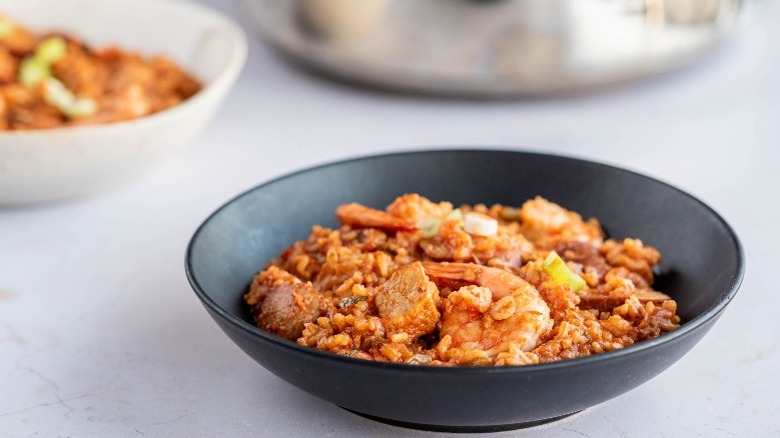
Ingredients
- 1 ½ cups long grain white rice
- 1 pound chicken breasts, cut into 1-inch cubes
- 1 teaspoon cayenne, divided
- 1 teaspoon salt, divided
- 1 teaspoon pepper, divided
- 2 tablespoons butter
- 1 (13 ½-ounce) andouille sausage rope, sliced
- 1 cup diced Vidalia onion
- 1 cup diced green bell pepper
- 1 cup chopped celery
- 4 garlic cloves, minced
- 1 tablespoon Worcestershire sauce
- ¼ cup chopped parsley
- 1 (28-ounce) can crushed tomatoes
- 1 ½ cups tomato purée
- 1 tablespoon creole seasoning
- 1 tablespoon Louisiana hot sauce
- 3 bay leaves
- 3 cups chicken broth
- 1 pound shrimp (about 16 to 20), deveined and tails on
- ¼ cup chopped scallions
Directions
- Rinse the rice thoroughly, running under water until the water runs clear. Set aside until ready to use.
- Season cubed chicken with ½ teaspoon of cayenne, ½ teaspoon of salt, and ½ teaspoon of pepper. Melt butter in a very deep skillet or pot over medium heat and cook chicken until cooked through, about 5 minutes. Remove from pot and reserve.
- Add sliced sausage to the pot and cook until caramelized, about 5 minutes, scraping up any browned bits and seasoning leftover from the chicken.
- Once sausage is deeply browned, add the onion and stir.
- Once the onion begins to soften, add the bell pepper and celery and cook until the trinity is softened, about 3 to 4 minutes. Stir in the garlic.
- Add the Worcestershire sauce and stir to scrape any browned bits from the bottom of the pot. Stir in the parsley, then add the crushed tomatoes and tomato purée. Stir in the creole seasoning, hot sauce, and bay leaves.
- Add the rinsed rice to the pot and stir in the broth, incorporating well so that rice is submerged. Return the cooked chicken to the pot and bring the mixture to a boil, then reduce heat to medium low and cover.
- Simmer, stirring occasionally, until liquid is absorbed and rice is fluffy, about 15 to 20 minutes.
- Once rice is cooked, remove pot from heat and gently stir in the shrimp. Cook in the residual heat of the jambalaya until pink and opaque, about 3 minutes. Use the remaining cayenne, salt, and pepper to season to taste.
- To serve, top with chopped scallions.
